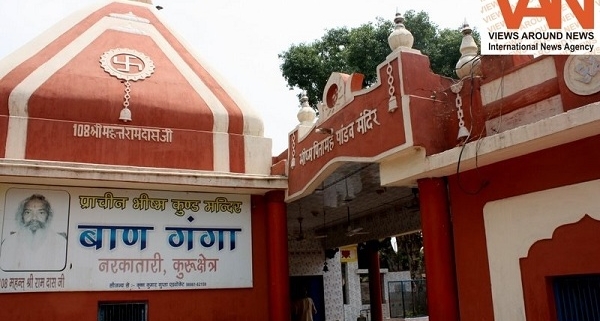BANGANGA NARKATRI, NEAR BY HOME STAY HOTEL KURUKSHETRA
Pitamah Bisham is said to have rested on a bed of arrows at this location during the Mahabharata, where he is said to have seen the famous battle after Arjun. The Banganga or Bisham Kund, a large water tank, now has a shrine next to it.
In addition to being the grandfather of the Kauravas and the Pandavas, Bhishma was a combat warrior. He was invincible since he was the son of Goddess Ganga and a pupil of legendary instructors. He was forced to fight on the side of the Kauravas in the Mahabharata due to various political reasons, but he pledged not to murder any of the Pandavas. Because he loved the Pandavas so much, he made this promise. Furthermore, the entire world was aware of the long history of Kauravas’ oppression of the Pandavas. At times, the Kauravas challenged him to break his promise. To get out of the situation, he gave the Pandavas a secret plan to assassinate him. Arjuna killed him with arrows that pierced his entire body and left him laying on a bed of arrows later thanks to this assistance. As Bhishma lay wounded on the battlefield, he began to suffer from dehydration. When Arjuna was desperate to quench his thirst, he launched an arrow into the ground, which resulted in an erupting jet stream of water. Mother Ganga, who came to quench her son’s thirst, was the water stream. Since Bhishma received the blessing of Ichcha Mrityu (schedule the death), he chose to die when the sun went into the northern hemisphere. Around him, he taught them about life and how to lead a kingdom while they were all busy with their own concerns. Bhishma Kund is the name given to the stream’s source, which was transformed into a pond. Bhishma means grandsire in Sanskrit, whereas kund means water tank or pond in English. Also, a temple was established in the premises known as Bhishma Narkatari Temple.
It’s said that this tank of water has a mythology tied to it. It’s said that Bhishma sought for water while he was lying on his bed of arrows because he was thirsty. Arjuna discharged an arrow into the ground and unleashed a torrent of water in order to achieve his goal. So it’s said that the Bhishma Kund came to be.
Taxis and Auto rickshaws are readily available throughout the city for transportation.
Kurukshetra is connected to major cities like Delhi and Chandigarh via Haryana Roadways Buses and other surrounding State Corporation Buses. Many buses travel between the city of Delhi (160 km), Ambala (40 km), and Karnal (39 km). For a trip from Delhi to Kurukshetra, a private A/C bus costs roughly Rs 1,500.
At Kurukshetra, you can catch a train to almost any station in the country, as it is a significant railway junction.
Delhi and Chandigarh are the closest airports to Kurukshetra, which are accessible by road and train. The airports also offer taxi services. All major cities in India and overseas have direct flights into Delhi’s international airport. Distance from Delhi to Kurukshetra is 160 kilometres.



